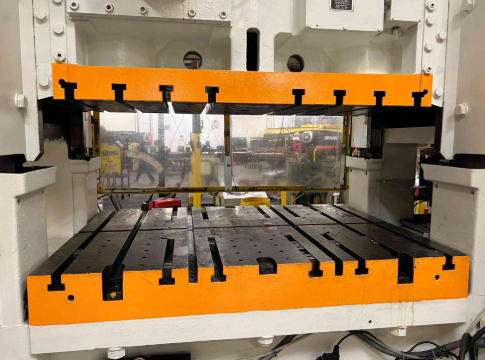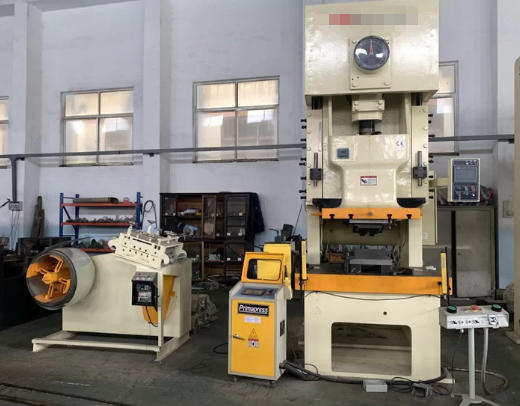Views: 222 Author: Rebecca Publish Time: 2025-11-16 Origin: Site









Content Menu
● Understanding the Role of Punch Presses in Tableware Manufacturing
● Proactive Maintenance Philosophy
● Weekly Maintenance Essentials
● Monthly Deep-Dive Inspections
>> Material Handling and Feeding
● Lubrication and Cooling Strategies
>> Cooling System Optimization
● Preventive Maintenance Scheduling and Documentation
>> Maintenance Calendar Framework
● Quality Control and Process Stability
>> Process Validation and SOPs
>> Changeover and Tooling Records
● Common Failure Modes and Their Mitigation
>> Ram Guides and Bearings Wear
>> Hydraulic and Pneumatic System Degradation
● Industry-Specific Considerations for Tableware Production
● Material-Specific Adjustments
● Training and People-Centric Maintenance
● Case Study: A Typical 3-Pocket Punch Press Line in a Disposable Tableware Plant
>> Practical Quick Start for Your Plant
● FAQ
>> Q1. How often should punch press dies be replaced in tableware production?
>> Q2. What cooling methods work best for high-speed tableware stamping?
>> Q3. How can operators contribute to extending tool life?
>> Q4. Which metrics are most useful for preventive maintenance in this context?
>> Q5. When is it appropriate to upgrade a punch press versus continuing maintenance?
Punch press machines are at the heart of many tableware manufacturing lines, from shaping aluminum vessels to stamping precise lids and cutlery components. In the restaurantware and disposable tableware sectors, reliable tooling translates to consistent product quality, reduced downtime, and lower total cost of ownership. This guide provides practical, industry-tailored maintenance strategies to keep punch presses performing at peak efficiency, reduce scrap, and extend equipment life in a high-demand production environment.

Punch presses transform raw material sheets into finished components like cup rims, lids, plate bases, and small utensils. They handle high-speed, high-torque cycles, generating heat, wear, and vibration. Understanding cycle patterns, tool layouts, and material properties helps prioritize maintenance tasks and predict potential failures before they disrupt production.
Adopt a proactive mindset rather than a reactive fix-it-when-it-breaks approach. Regular inspections, scheduled lubrication, and tool condition monitoring reduce emergency stops and extend component life. Document maintenance activities to establish a baseline and track improvements over time.
- Inspect guards, interlocks, and emergency stops to ensure operator safety and uninterrupted runs.
- Verify that lubrication reservoirs are filled to the correct levels and that automatic lubrication systems are functioning.
- Check for unusual noises, vibration, or changes in belt tension.
- Confirm tool racks are properly secured and that feeds, stops, and die-clearance settings align with the job ticket.
- Ensure hydraulic or pneumatic circuits show no leaks and maintain appropriate pressures.
- Clean conveyor surfaces, chutes, and feed areas to prevent material buildup that can skew alignment.
- Inspect die sets for signs of wear, misalignment, or cracks; replace or re-shim as needed.
- Check bearings, bushings, and sliders for smooth operation; apply the recommended grease or oil per manufacturer specs.
- Tighten fasteners on press frames, ram guides, and tool holders to prevent gradually increasing play.
- Verify cooling systems or flood cooling fluids are clean and within specified temperature ranges.
- Perform a die-shop check: measure clearances, die heights, and punch diameters; calibrate as required.
- Inspect the hydraulic or servo motor actuators for signs of overheating, leakage, or degraded seals.
- Test stroke height, ram runout, and alignment between upper and lower tooling; adjust shims or guides if necessary.
- Inspect electrical panels for loose connections, corrosion, or dust buildup; verify protective measures are intact.
- Review lubrication intervals and adjust as production intensity changes or when using new materials.
In tableware applications, tooling wear directly affects form integrity, edge quality, and sealing surfaces. Proper tool management is essential for consistent product quality.
- Use corrosion-resistant coatings or lubricants compatible with the material being stamped (e.g., aluminum, stainless steel, or coated metals used in disposable tableware).
- Install anti-adhesion coatings or use partitioned die designs to reduce sheet-to-die sticking, particularly with starch-containing or coated materials.
- Implement a die-cleaning protocol after each shift to remove metal fragments, dust, and residue that can promote wear.
- Maintain die height and alignment with reference gauges; replace worn punches to avoid ovality or irregularities in stamped parts.
- Ensure consistent, vibration-free feeding to minimize tool impact fluctuations.
- Use appropriate feed speeds that align with material thickness and hardness to prevent chipping or edge burrs.
- Regularly check rollers, guides, and feed fingers for wear and replace as needed.
Lubrication reduces friction, heat buildup, and wear, while cooling maintains polymerized or heat-sensitive materials' integrity and protects tooling.
- Follow the manufacturer's lubrication chart for each component: slideways, gears, bearings, and ball screws.
- Use synthetic or semi-synthetic lubricants that resist oxidation and provide stable viscosity across production temperatures.
- Implement an intermittent lubrication schedule that matches production cycles to minimize lubricant film breakdown.
- Monitor lubricant cleanliness; replace filters and maintain clean reservoirs to prevent ingesting particulates into the tooling.
- For high-speed stamping, maintain consistent coolant flow, temperature, and filtration to prevent overheating of the workpiece and tooling.
- Inspect hoses, nozzles, and heat exchangers for blockages or leaks; replace damaged components promptly.
- Consider mist or flood cooling options for sensitive alloys or multilayer tableware components to prevent warping or surface oxidation.
A structured PM schedule improves predictability and asset lifespan.
- Daily: startup checks, quick clean, lubrication verification.
- Weekly: die inspection, belt tension, and alignment checks.
- Monthly: deep die inspection, motor and actuator diagnostics, electrical panel audit.
- Quarterly/Annually: comprehensive mechanical and electrical systems audit, hydraulic oil changes, and software or controller firmware updates.
- Track downtime, scrap rates, and maintenance durations to identify repeating issues.
- Use instrumented sensors to monitor vibration, force, and temperature during runs; set alert thresholds to catch anomalies early.
- Create a maintenance log with parts replaced, costs, and lead times to support procurement planning and lifecycle cost analysis.

Stable processes are less demanding on equipment and yield higher-quality tableware components.
- Develop standard operating procedures for setup, changeovers, and preventive maintenance tasks.
- Validate that die clearance, punch diameters, and stamping depth meet tolerances for each product line.
- Use SPC (statistical process control) where applicable to monitor process variation and preempt drifts that stress tooling.
- Record every changeover with job number, material grade, thickness, and stamping parameters.
- Attach a bill of materials and a tooling map to each job to ensure consistent part quality and easy traceability.
- Schedule preventive maintenance tasks around planned changeovers to minimize production interruptions.
Maintenance should not compromise operator safety. Protective guards, lockout/tagout procedures, and clear signage are vital.
- Enforce lockout/tagout procedures during maintenance and die changes.
- Use dual-channel safety interlocks on access doors and guarded areas.
- Train operators to recognize unusual noises or motion, and to report issues promptly.
Understanding typical wear patterns helps tailor maintenance programs to the tableware sector.
- Root causes: misalignment, insufficient lubrication, material hardness, and excessive tonnage.
- Mitigation: correct alignment, timely lubrication, appropriate tonnage per material, and scheduled die refurbishments.
- Root causes: contaminants, improper lubrication, and overloading.
- Mitigation: protect against dirt ingress, maintain proper lubrication intervals, and monitor load limits.
- Root causes: seal leaks, overheating, and fluid contamination.
- Mitigation: replace seals at recommended intervals, monitor system temperatures, and use clean, compatible hydraulic fluids.
The tableware sector often involves thin-walled or coated materials, and strict cosmetic requirements.
- Aluminum-based tableware components require precise edge finishing to prevent burrs that could injure users.
- Coated materials need compatibility checks with lubricants to avoid coating degradation or staining.
- Biodegradable or compostable materials may have different stamping resistance and could demand adjusted clearance or pressure settings.
- Ensure compliance with relevant safety and food-contact standards for disposable tableware components.
- Maintain traceability for each batch of stamped parts to support quality audits and recalls if necessary.
A well-trained crew can spot early signs of wear and contribute to longer machine life.
- Involve operators in routine inspections and lubrication tasks to build ownership and reduce overlooked maintenance.
- Provide visual aids, checklists, and quick-reference guides at the workstation.
If a punch press is showing persistent inefficiencies, consider targeted upgrades.
- Recurrent, expensive downtime due to tool wear or control system faults.
- Inability to meet evolving quality standards or higher production rates without compromising tool life.
- Availability of modular components and serviceable parts that extend the machine's usable life.
- Upgrading control systems for better precision and process monitoring.
- Replacing worn mechanical components with more durable alloys or coated surfaces.
- Implementing automated lubrication and advanced cooling for tighter tolerance stamping.
In a mid-sized facility producing biodegradable plates and lids, a compact 30-ton punch press handles multiple die sets with 0.5–1.0 mm sheet thickness. The maintenance team implemented a daily 15-minute startup check, a weekly die inspection, and a monthly full calibration, coupled with lubricant conditioning and coolant filtration upgrades. Within six months, scrap rates dropped by 28%, unplanned downtime reduced by 42%, and tool life extended by approximately 15–20%. This example illustrates how disciplined PM, precise die management, and targeted upgrades yield measurable gains in a dynamic tableware workflow.
- Create a one-page maintenance checklist aligned to your specific press model and tooling.
- Map every die to a corresponding process parameter and expected wear pattern.
- Establish a two-tier lubrication plan: a basic daily routine and a more thorough weekly schedule.
- Invest in a simple data-logging system to monitor key indicators like cycle time, tonnage, and temperature.
Maintaining and extending the life of a punch press in the tableware manufacturing sector is about disciplined practices, precise tooling management, and proactive rather than reactive intervention. By aligning maintenance with the specific demands of disposable tableware production, facilities can reduce downtime, preserve product quality, and maximize equipment life. Emphasize regular inspections, proper lubrication, tool condition monitoring, and safety, while staying open to strategic upgrades when they become economically justifiable.

A1. Replacement frequency depends on material, stamping depth, and cycle counts. Establish a die life baseline through initial testing, monitor wear indicators, and plan replacements before critical tolerances are violated.
A2. Flood cooling with clean coolant and proper filtration generally yields stable temperatures and material quality; mist cooling can be useful for heat-sensitive materials but may require tighter control of aerosols in the workplace.
A3. Operators should perform daily checks, keep dies clean, report unusual wear promptly, and adhere to lubrication schedules. Regular training reinforces these habits.
A4. Downtime, scrap rate, mean time between failures (MTBF), tool life, and cycle time variations are valuable for assessing maintenance effectiveness and planning upgrades.
A5. If downtime and scrap persist despite PM, or if quality targets require tighter tolerances that the current system cannot consistently meet, upgrading control systems, lubrication, or tooling may be cost-effective.
Why The Right Punch Press Machine Is Crucial for High-Quality Tableware Production?
Punch Press Machines: The Backbone of Efficient Cutlery Production
How To Choose Between Manual And Automatic Punch Press Machines?
Best Punch Press Machines for Small And Large-Scale Manufacturers
Top Manufacturers of Punch Press Machines for The Tableware Industry
What Are The Key Benefits of Investing in A Punch Press Machine for Your Factory?
How Punch Press Machines Are Revolutionizing The Cutlery Industry?
The Role of Punch Press Machines in Modern Kitchenware Production Lines
Punch Press Machine Vs. Turret Punch Press: What's The Difference?
